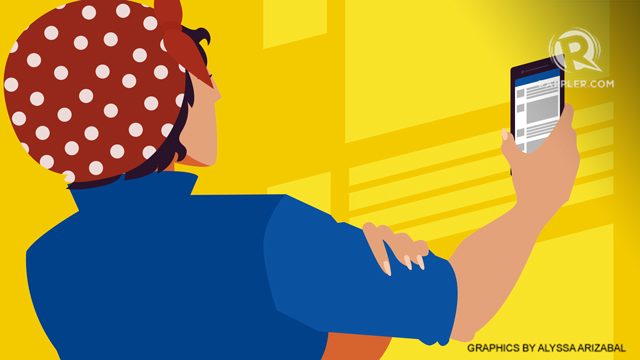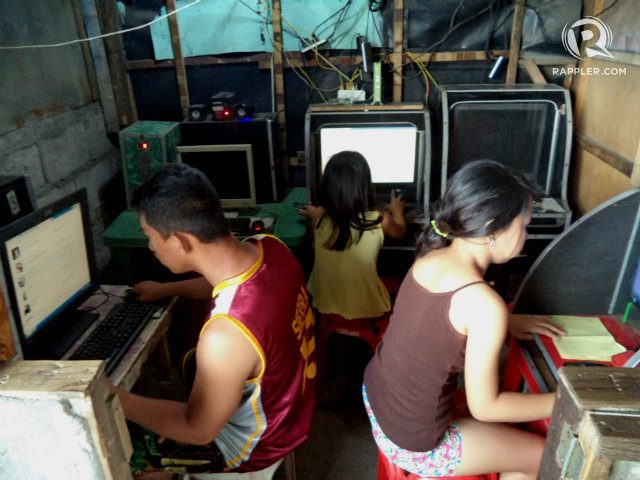SUMMARY
This is AI generated summarization, which may have errors. For context, always refer to the full article.

MANILA, Philippines – What is the measure of Filipino women’s rights online?
On a scale of 1 to 10, with ten being the highest, the Foundation for Media Alternatives (FMA) gave the Philippines an overall score of 5 in its digital gender report card.
The score simply means that a glaring online gender divide still exists in the country. Based on the Digital Gender Report released by the FMA on Thursday, April 6, despite having a high social media penetration in the country, women do not enjoy the same rights as men online.
“Not all women are included in the digital revolution and basically it is because of the policies. What we are saying is that if this is the gap, there is failure in terms of policies, and that there is something that we can do to revise,” FMA Executive Director Liza Garcia explained.
The Philippines is not alone in this dilemma.
To take the first step in addressing the digital divide women face, the World Wide Web Foundation (WWWF) initiated a digital audit which aims to measure women’s rights in 10 different countries.
In its 2016 report, WWWF said that none of the 10 countries they assessed – Kenya, Uganda, Mozambique, Nigeria, Ghana, Egypt, Colombia, India, Indonesia, and the Philippines – are doing nearly enough to achieve the Sustainable Development Goal (SDG) gender and ICT targets by 2030.
“Only one country (Colombia) scraped a passing grade, with an overall mark of 60%. Without a major escalation of policy effort and investment, most of the benefits of technological change in all 10 countries will be captured by men — making gender inequality worse, not better,” the report added.
Socioeconomic disparity
Zeroing in on the experience Filipino women face online, FMA assessed empirical sources such as reports, surveys, and existing legislation from each of the countries in their digital gender report.
The results of the study spoke volumes about the subtle forms of inequality women face in the digital world.
The overall country score was based on 14 indicators provided by the WWWF that were grouped into 5 main thematic categories: Internet access and women’s empowerment, relevant content and services, online safety, affordability, and digital skills and education.
With a measly grade of 4 out 10 for its category on Internet access and women’s empowerment, the Women’s Rights Online study showed that while the gender gap in Internet access is closing in urban areas, few women in poor areas of Manila have used the Internet to look for important information on their rights (18%) or voice their opinions online (8%).
This was echoed by Natividad Pilipina of “Nagkakaisang Tinig ng Hanay ng Kababaihan ng Kalookan” who said that there should be more studies that attempt to include women and youth from the urban poor sector.
“Kapag hanapin ‘yung missing link, usapin pa rin ito ng ekonomiya. Kasi maraming naiiwan na kababaihan epsecially sa urban poor,” Pilipina added.
(If you look at the missing link, you will understand that it is anchored on the issue of economic [disparity]. That is because most women in the urban poor are being left behind.)

Looking into government-provided information on women’s reproductive health and sexual rights, the Philippines also scored 4 out 10 for the category on “Relevant content and services.”
According to the study, while the government provides online information about the topic, they are often not easy to locate. Additionally, just 5% of women have access to mobile financial services.
But this is not enough, according to Grace Mirandilla-Santos of the Internet Society-Philippine Chapter.
Aside from looking into the socioeconomic disparity that comes into play when measuring relevant content and services for women online, Santos also highlighted the importance of assessing how women become online content creators themselves.
“How can women be content creators? It is not just about accessing content or data online. It is also about giving opportunities to other women to create their content,” Santos explained.
Online safety
Of the 5 categories, FMA gave the highest score for the category on “Online Safety,” with a grade of 7 out of 10, supposedly due to the country’s pro-women laws online.
Women rights advocates present at the forum, however, pointed out that not all existing laws bear teeth.
Chang Jordan of Women’s Legal and Human Rights Bureau cited the experience of Nicole De Castro when she was sexually harassed by men online after she expressed her dissent over the burial of late dictator Ferdinand Marcos in the Libingan ng mga Bayani.
“Harms, sexual violence, and discrimination – these constitute the world where Filipino women live in both offline and online,” Jordan said in mixed English and Filipino. (READ: The many faces of sexual harassment)
Meanwhile, the country scraped a passing score of 6 out 10 for the category on “Affordability.” The report attributed the relatively high score to the country’s commitment to establish free nationwide Wi-Fi in public places. A new national broadband plan is due to be adopted within the next year. However, the Philippines has the second lowest Internet speed in the region at 3.2 Mb per second.
However, Santos added that promos offered by service operators should not be indicators of affordability.
“Affordability should be measured in terms of GNI per capita which is basically the average monthly income. I’d like to point out that while the costs of mobile service that you access are going down, these are basically indicators of promos. The problem with promos is that anytime, service providers can change it,” Santos explained.
Meanwhile, an alarming estimate of 79% of the country’s public primary and secondary schools lack Internet connectivity. Because of this, the country only scored 5 out of 10 in the category of Digital Skills and Education in the gender report card.
Closing the gender gap
While the study proved that gender divide still exists online, women’s rights advocates are optimistic that the picture is not all that grim.
How can we accelerate the bridging of the gender gap?
FMA, in consultation with other national stakeholders, suggested a 5-action plan which the Philippine government can take to address the challenges identified during the forum. It includes:
-
Integrating gender into the Philippines’ national ICT plan
-
Improving internet affordability and speed
-
Implementing inclusive digital literacy programmes
-
Conducting gender audits of government agency websites
-
Ending online gender-based violence.
For FMA, the Digital Report Card is a big step towards the end goal of bridging the gender gap which exists both online and offline.
Garcia said that the organization is committing to accomplish all the points included in the Action Plan, but emphasized that “the scorecard is just the starting point for broader regional and global consultation.” – Rappler.com
Add a comment
How does this make you feel?
There are no comments yet. Add your comment to start the conversation.